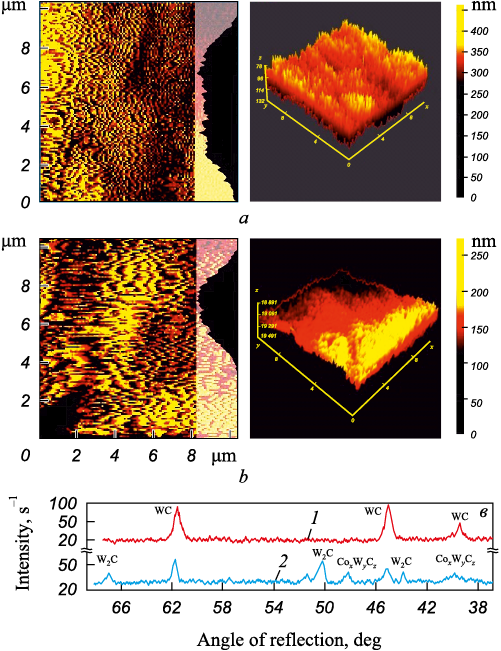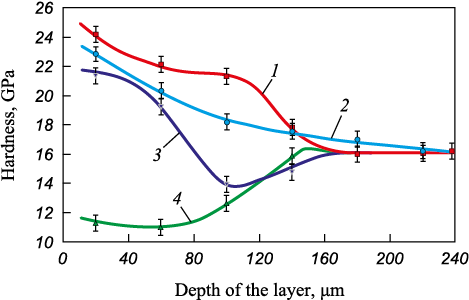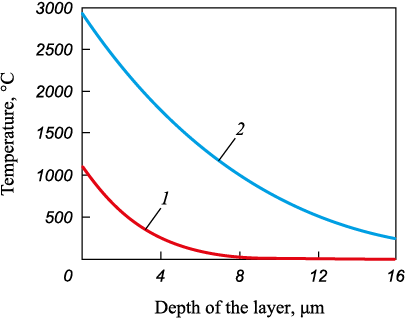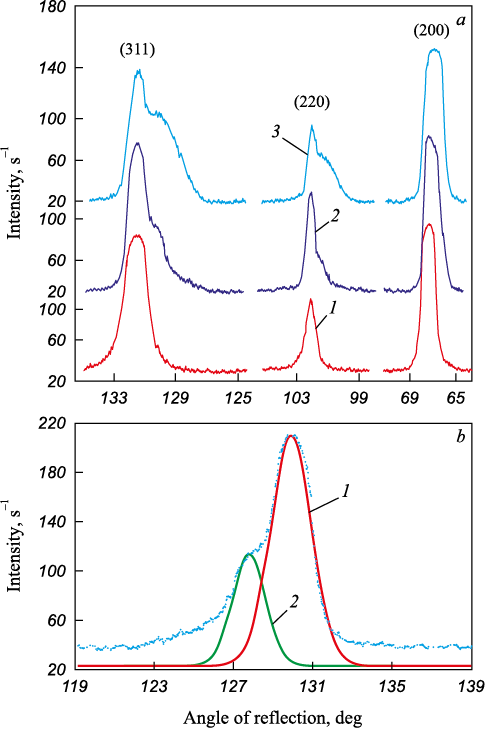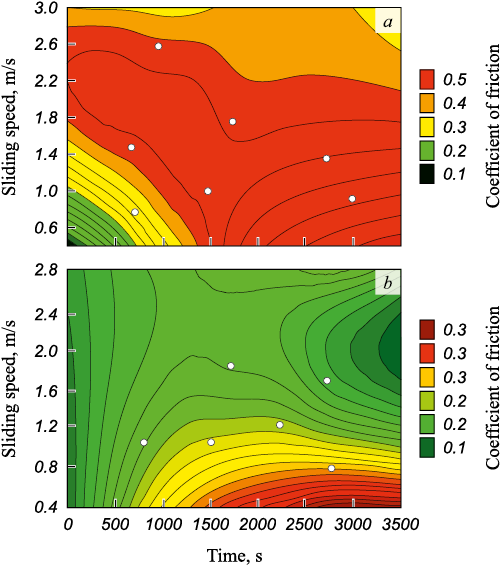Scroll to:
Structural organization and properties of surface layers of WC–Co hard alloys after pulsed laser processing
https://doi.org/10.17073/0368-0797-2023-2-177-183
Abstract
The article presents the metal-physical studies results of the structure formation effects in surface layers in the hard alloys of the WC–Co system under extreme thermal and deformation effects of pulsed laser radiation. It is shown that the structural organization and properties of hard alloys VK6, VK8, VK10 upon radiation treatment with a power density of 175 MW/m2 are determined by state of the zones which are formed around carbide inclusions due to the various kinds of stresses appearance at the “carbide-bond” composition boundaries, including thermostrictive and phase stresses. The result is dissolution of the carbides boundary zones due to contact melting, which is accompanied by mutual mass transfer of atoms at the boundaries in the “carbide-bond” system with the possible formation of a thin amorphous-like super hard shell. These processes make it possible to create compositions in hard alloys with a set of differentiated properties specified by varying the laser treatment process parameters and composition of the starting materials. After laser alloying with a radiation power density of 200 MW/m2, temperature gradients and thermal stresses appearing in the surface layers of hard alloys with coatings (cobalt, nickel) contribute to convective mixing of the molten coating components and their penetration into the hard alloy to a depth of more than 20 μm. Simultaneously, despite the extremely short laser pulse time (10–3 s), mass transfer of tungsten, carbon and titanium atoms from the melted boundary zones of carbides to the adjacent bond zones with their hardening is possible in the irradiated zones. It was established that after high-temperature laser heating, carbides, in contrast to the initial ones, achieve a globular shape of grains. They are dispersed, and stoichiometric characteristics change in the local zones bordering the bond (the complex type carbide CoxWyCz is formed). As a result, due to these processes, the surface layers’ viscosity of hard alloys and the irradiated products performance increase. Compared to non-irradiated samples of hard alloy, the ultimate strength increases by 15 %, strength and durability – by 30 – 40 %.
For citations:
Brover G.I., Shcherbakova E.E. Structural organization and properties of surface layers of WC–Co hard alloys after pulsed laser processing. Izvestiya. Ferrous Metallurgy. 2023;66(2):177-183. https://doi.org/10.17073/0368-0797-2023-2-177-183
Introduction
Modern manufacturing relies heavily on the use of high-performance hard alloys due to their superior combination of high hardness, strength, and absence of adhesion integration when in contact with metals during friction. These properties give them a significant advantage over other instrumental materials [1 – 3].
However, during operation, items made from hard alloys are subjected to stresses and strains that accumulate with the internal thermal stresses already present in machine parts and tools. This often leads to early wear and tear and eventual destruction of these components [4 – 6].
One way to improve the operational performance and increase the lifetime of hard alloy items is to modify the composition and structure of their surface layers through high-energy processing [7 – 10].
However, the structural transformations that occur during rapid thermal processing are complex, and the search for ways to decrease the brittleness of surface layers of hard alloys and increase their operational reliability is ongoing.
One promising method is the doping of surface layers of hard alloys through laser heating, where a high density of laser power is used to melt preliminary applied coatings and the thin substrate underneath the layer. Under these conditions, a wide range of chemical and microstructural states can be achieved as a result of sharp cooling from the liquid phase. These possible types of microstructures can include a wide range of solid solutions, metastable crystalline phases, and metallic glasses.
To clarify the reasons behind the improvement in properties resulting from laser processing and doping of hard alloys, this study conducted a series of experiments to irradiate these materials and determine the main structural changes.
Experimental
This study aimed to investigate the effects of surface laser processing on hard alloys VK6, VK8, VK10. Pulsed laser irradiation was carried out using a Kvant-16 facility, and various paraments were varied, including the irradiation energy, beam defocusing degree (3 – 6 mm), irradiation duration (1 ÷ 6)·10\(^{-}\)3 s, to achieve a wide range of irradiation power densities (70 – 250 MW/m2). The phase composition and material structure of the alloys after laser processing were analyzed using scanning probe microscopy, diffractometry and durometric methods.
Results and discussion
This study focused on the metallophysical properties of hard alloys containing tungsten carbides WC and cobalt bonds.
The modes of laser processing of the alloys were determined using MathCAD software. The quality requirements for the irradiated surface and changes in the initial structure were defined as follows: no significant alteration of the initial microgeometry of the sample surface and no occurrence of a microcrack network. The carbide grains and cobalt bond were required to be fused to a depth of approximately 2 μm.
It was found that laser irradiation of hard allots should be performed at a power density of 175 – 200 MW/m2.
Two variants of laser processing were applied. In the first case, the surface of hard alloys was coated with a thin layer of coal-tar varnish to increase its absorbing capacity, and then irradiated with a power density of 175 MW/m2. In the second case, the samples were coated with cobalt powder or galvanic coating and irradiated with a power density of 200 MW/m2, resulting in doping of the surface layers of hard alloys using laser.
The structure of hard alloy VK8 before and after laser processing without doping was studied using a scanning probe microscope (SPM) operating in the mode of atomic force microscopy (Fig, 1, a, b). The results showed that the laser processing led to a smoothing of the relief of sample surface.
Fig. 1. Scanned images of VK8 hard alloy before (a) and after (b) |
The relief height of carbide phase decreased after irradiation to 100 – 250 nm (Fig. 1, b), compared to the initial relief height of 150 – 400 nm (Fig. 1, a), which suggests that the carbide grains fused and underwent structural changes in the surface layers of hard alloys during laser processing.
To gain a deeper understanding of the structure formation processes during laser irradiation of VK8 hard alloy, X-ray studies were conducted. These studies detected reflection of various phases in the diffraction patterns (Fig. 1, c, curve 2), including tungsten carbide (WC), metastable tungsten carbide (W2C), and minor amount of binary carbides СоxWyСz .
It should be noted that tungsten carbide W2C, which forms during laser processing and has a higher hardness than the initial carbide WC (29.4 and 24 GPa, respectively) [10 – 12], promotes the hardening of surface layers in the irradiated hard alloy.
The detection of complex carbides СоxWyСz , in the diffraction patterns, as well as the changes in carbide grain sizes observed during SPM analysis, provide evidence of nontrivial structure formation processes at the interfaces between carbide and bond composition during laser processing.
The structural organization of local zones at the boundaries of carbide with cobalt bond, formed through high-temperature impact of pulsed laser irradiation and possessing high structure dispersity, increased hardness and wear resistance, was investigated. The formation of these zones is attributed to the liquid alloy shell, that forms around carbides during laser fusion, which promotes the accelerated mass transfer of carbon atoms and dopants from carbides to the adjacent bond layer. The resulting binary carbides were observed in the diffraction patterns.
Analysis of changes in the microstructure of surface layers of hard alloys after laser irradiation demonstrated that martensitic transformations occur in the cobalt bonds, resulting in the transition of bonding cobalt from cubic to hexagonal modification and an increase in deformational properties.
It was also observed that upon laser processing with fusion, the initial carbide and bonding phases are dispersed, the specific surface area of carbide–carbide and carbide–bond interfaces increases, and transformations occur in the cobalt bond.
One method of increasing the viscosity of surface layers in hard alloys is to increase the fraction of cobalt or nickel bonding phase in surface layers. For example, increasing the cobalt content from 3 to 30 % increases the viscosity of hard alloys from 1.3·10\(^{-}\)4 to 5.0·10\(^{-}\)4 J/m2 [11].
Laser processing of hard alloys using saturating dressing and coatings was performed with consideration for microstructural design, which involves the formation of various materials on the surfaces to provide the desired operational properties. It was taken into account that fine-grain dispersed states and microstructures that facilitate the maximum deceleration, deviation, branching, and interaction of cracks are the most promising for forming high-strength states with guaranteed reserve of viscosity in the surface layers [13 – 16].
Doping of surface layers with cobalt or nickel was performed in order to decrease micro stresses ion hard alloy. When fusing a metal bond (cobalt or nickel), the porosity decreases significantly in both sizes and pore amount.
Upon laser irradiation, carbides undergo melting and transform from angular to globular shape, which reduces stress concentration in the surface layer and improves crack resistance. This also facilitates the absorption of molten cobalt or nickel from coatings into the surface layers.
The hardening effect of hard alloys due to laser irradiation can be analyzed by examining the microhardness distribution curves over the depth of the irradiated segment (Fig. 2). The depth of laser impact is 60 – 120 μm, which is 3 – 5 times deeper than the depth of the fused layer by.
MathCAD software was used to calculate the temperature distribution over the depth of VK10 hard alloy upon laser irradiation, which demonstrated that the melting point of tungsten carbides (Tmelt = 2600 K) and cobalt bond is not reached at this depth, but the hardness remains high (Fig. 3).
Fig. 2. Hardness distribution over the depth of hardened layer
Fig. 3. Temperature distribution over the depth |
This suggests that the hardening effect of hard alloy is related to the formation of local zones at the grain boundaries in carbide-bond composition, which occurs due to the joint action of various stresses, such as thermal striction stresses caused by high temperature gradients and stresses related to thermal physical coefficients in the composition.
According to the proposed model, the conditions for contact fusion and possible formation of a thin shell of liquid alloy are generated in the direct vicinity of boundaries in the carbide-bond composition upon irradiation, which promotes accelerated mass transfer of carbon atoms and dopants from carbides to the adjacent bond layer. After rapid crystallization, a superhard shell can be formed around the carbides, leading to additional hardening of local zones of hard alloy and is observed upon measurement of microhardness (Fig. 2, curve 1).
This proposed model is supported by experimental results, which demonstrate that contact fusion can occur at temperatures hundreds of degrees below the melting point of the system components [12]. Additionally, it was observed that the microhardness of cobalt bond increases from 1660 to 3440 MPa during the dissolution of 6 to 30 % WC.
Therefore, the observed hardening effect (Fig. 2, curve 1) of VK10 hard alloy after laser processing can be attributed to the formation of tungsten carbides W2C, which have higher hardness than the initial carbide WC, and the dispersion of the carbide phase due to grain boundary interaction in the carbide–bond composition [13 – 16].
Laser doping with cobalt or nickel (Fig. 2, curves 3 and 4) results in a decrease in surface layer hardness, which leads to an increase in their viscosity and crack resistance, particularly with the use of nickel doping coatings. This is due to the possibility of plastic deformation of bond material and its dynamic polygonization under extreme thermal deformation conditions during laser processing. As a result, the bond can develop a disperse structure when there is a sufficiently high density of defects in the crystalline structure.
In order to investigate and verify these processes of structure formation occurring in the bonding material during laser irradiation, experiments were conducted on laser processing of a model nickel alloy, which simulates the structural transformations in the hard alloy bond during laser processing.
Thin nickel samples were subjected to diffractometry analysis before and after laser surface irradiation. The diffraction pattern (Fig. 4, a, curve 2) exhibited a blurring and asymmetric nickel reflection compared to the similar reflections of the nickel diffraction pattern before laser processing (Fig. 4, a, curve 1), especially the reflection (311). The triplet pattern of the diffraction lines is noteworthy. The trend of the first maximum shearing towards lower reflection angles and the second maximum shearing towards higher angles is distinctly observed, indicating the occurrence of lattice distortions and defects in atom packing. These distortions are a consequence of dynamic effects such as local plastic shears upon laser irradiation.
Fig. 4. Fragments of diffractograms (a) of nickel samples |
The diffractometry results were analyzed using the New Profile software package, which allowed for the subdivision of the complicated profile of the imposed diffraction peaks of the reflection (311)Ni (Fig. 4, b).
During the computer processing of the obtained reflection profiles, it was determined that before laser processing, the reflection (311)Ni was recorded at 2θ = 131.55558° with an interplanar distance d/n 1.06142. After laser irradiation, two reflections were observed: a lower intensity reflection at 2θ = 130.1939° with a d/n = 1.0672 and higher intensity reflection at 2θ = 131.45776° with a d/n = 1.06184.
These findings indicate changes in the lattice constant of nickel and the occurrence of significant dynamic lattice distortions.
It can be concluded that laser processing results in a diffusion-free transformation of the face-centered lattice of nickel into a face-centered rhombic lattice with a moderate degree of rhombicity (c/a = 1.005). This transformation occurs due to the presence of a sufficiently high amount of defects in the crystalline structure and the possibility of local plastic shears in the bond upon rapid laser heating.
It should be noted that the bond content in the surface layers of hard alloys is one of the determining factors of their long lifetime [1; 17 – 19].
Peculiar attention is drawn to the experiments involving laser surface doping of VK10 hard alloy with a nickel coating and the addition of powdered TiC (Fig. 2, curve 2). This irradiation variant is characterized by a monotonous decrease in hardness to initial level. Furthermore, the hardness is somewhat lower compared to laser irradiation without coatings. An important point to note is the expected increase in viscosity due to the modification of the chemical composition of the surface layers by fusing titanium carbides.
Therefore, if the addition of cobalt or nickel hard alloy to the surface layers has a certain influence on their viscosity, the use of powdered nickel with titanium carbides provides an opportunity to change the functional purpose of the irradiated items.
As a result, composite materials are formed on the surface of WC–Co hard alloys that closely match the composition of the tungsten-free hard alloy of KNT type. The increased hardness of the surface layers of the hard alloy enables the transition from processing brittle materials such as cast iron to processing viscous materials such as steels using cutting tools made from laser-doped hard alloys.
These phase transformations and structure formation effects in the surface layers of the hard alloy during rapid laser processing and doping contribute to their overall high wear resistance.
The wear resistance of hard alloys was predicted after laser processing, and the operating mode for various friction conditions of hard alloy items was selected using Statistica software. Fig. 5 shows maps of regressive simulation (maps of level lines) of the coefficient of friction as a function of test time at various sliding speed in friction pairs [20]. Reference points were applied to the maps to confirm the suitability of selecting the operational mode of laser-irradiated hard alloys using the maps (Fig. 5, b) compared to non-irradiated samples (Fig. 5, a).
Fig. 5. Regression modeling maps of dependence |
Experiments were conducted using a MI-1M friction machine with a friction pair consisting of hard alloy and quenched steel ShKh15. The results confirmed the simulate results and demonstrated that the coefficient of friction of the irradiated hard alloy decreased by approximately two times, leading to an increase in wear resistance compared to the initial non-irradiated state.
Conclusions
It has been found that the hardening effect of WC–Co hard alloy after laser processing with a power density of 175 MW/m2 is associated with the formation of tungsten carbides W2C, which exhibit higher hardness than the initial carbide WC. Additionally, grain boundary fusion and mutual mass transfer of atoms in the carbide–bond composition can lead to the with formation of a superhard shell around the carbides. These processes disperse the carbide phase and bond, resulting in increased hardness and wear resistance of the surface irradiated layers of hard alloys.
Moreover, laser doping with a power density of 200 MW/m2 can promote convective mixing of molten components of coatings (cobalt, nickel) in the surface layers of hard alloys, due to the temperature gradients and thermal stresses that occur. This mixing can penetrate the hard alloy to a depth greater than 20 μm.
Despite the extremely short duration of the laser pulse (10\(^{-}\)3 s), mass transfer of tungsten, carbon, and titanium atoms from contact fused boundary zones of carbides to the adjacent zones of bond can occur in the irradiated zones, resulting in hardening.
Furthermore, it has been established that after high-temperature laser heating, the carbides acquire a globular grain shape, contrary to the initial state, and are dispersed. In addition, complex binary carbide is formed in the local zones adjacent to the bond, resulting in stoichiometric properties changes. As a result of these processes, the viscosity of irradiated surface layers of hard alloys improves, along with the operational efficiency of irradiated items.
References
1. Katancik M., Mirzababaei S., Ghayoor M., Pasebani S. Selective laser melting and tempering of H13 tool steel for rapid tooling applications. Journal of Alloys and Compounds. 2020;849:156319. https://doi.org/10.1016/j.jallcom.2020.156319
2. Wu X., Shen J., Jiang F., Wu H., Li L. Study on the oxidation of WC–Co cemented carbide under different conditions. International Journal of Refractory Metals and Hard Materials. 2020;94:105381. https://doi.org/10.1016/j.ijrmhm.2020.105381
3. Büttner H., Michael K., Gysel J., Gugger P., Saurenmann S., de Bortoli G., Stirnimann J., Wegener K. Innovative micro-tool manufacturing using ultra-short pulse laser ablation. Journal of Materials Processing Technology. 2020;285: 116766. https://doi.org/10.1016/j.jmatprotec.2020.116766
4. Davoren B., Sacks N., Theron M. Laser engineered net shaping of WC–9.2 wt % Ni alloys: A feasibility study. International Journal of Refractory Metals and Hard Materials. 2019;86: 105136. https://doi.org/10.1016/j.ijrmhm.2019.105136
5. Li X., Guan Y. Theoretical fundamentals of short pulse laser – metal interaction: A review. Nanotechnology and Precision Engineering. 2020;3(3):105–125. https://doi.org/10.1016/j.npe.2020.08.001
6. Cramer C.L., Preston A.D., Ma K., Nandwana P. In-situ metal binder-phase formation to make WC–FeNi Cermets with spark plasma sintering from WC, Fe, Ni, and carbon powders. International Journal of Refractory Metals and Hard Materials. 2020;88:105204. https://doi.org/10.1016/j.ijrmhm.2020.105204
7. Gabdrakhmanov A., Galiakbarov A., Gaisin I. Increasing efficiency of the laser action to materials. Materials Today: Proceedings. 2019;19(5):1965–1967. https://doi.org/10.1016/j.matpr.2019.07.052
8. Mariani M., Goncharov I., de Gaudenzi G.P., Popovich A., Lecis N., Vedani M. Mechanical and microstructural characterization of WC–Co consolidated by binder jetting additive manufacturing. International Journal of Refractory Metals and Hard Materials. 2021;100:105639. https://doi.org/10.1016/j.ijrmhm.2021.105639
9. Parker S.R., Whiting M.J., Yeomans J.A. Control of carbon content in WC–Co hardmetal by heat treatment in reducing atmospheres containing methane. International Journal of Refractory Metals and Hard Materials. 2017;66:204–210. https://doi.org/10.1016/j.ijrmhm.2017.02.009
10. Garcia-Ayala E.M., Tarancon S., Ferrari B., Pastor J.Y., Sanchez-Herencia A.J. Thermomechanical behaviour of WC–W2C composites at first wall in fusion conditions. International Journal of Refractory Metals and Hard Materials. 2021; 98:105565. https://doi.org/10.1016/j.ijrmhm.2021.105565
11. Chen Y., Chen H., Chen J.Q., Xiong J., Wu Y., Dong S.Y. Numerical and experimental investigation on thermal behavior and microstructure during selective laser melting of high strength steel. Journal of Manufacturing. 2020;57:533–542. https://doi.org/10.1016/j.jmapro.2020.06.041
12. Matthews S., Ansbro J., Berndt C.C., Ang A.S.M. Carbide dissolution in WC–17Co thermal spray coatings: Part 1 – project concept and as-sprayed coatings. Journal of Alloys and Compounds. 2020;856:157464. https://doi.org/10.1016/j.jallcom.2020.157464
13. Tolotti de Almeida D., Rosauro Clarke T.G., Corrêa de Souza J.H., Haupt W., Fernandes de Lima M.S., Mohrbacher H. The effect of laser welding on microstructure and mechanical properties in heavy-gage press hardening steel alloys. Materials Science and Engineering: A. 2021;821:141341. https://doi.org/10.1016/j.msea.2021.141341
14. Sridar S., Zhao Y., Li K., Wang X., Xiong W. Post-heat treatment design for high-strength low-alloy steels processed by laser powder bed fusion. Materials Science and Engineering: A. 2020; 788:139531. https://doi.org/10.1016/j.msea.2020.139531
15. Jucan O.D., Gădălean R.V., Chicinaş H.F., Hering M., Bâlc N., Popa C.O. Study on the indirect selective laser sintering (SLS) of WC–Co/PA12 powders for the manufacturing of cemented carbide parts. International Journal of Refractory Metals and Hard Materials. 2021;96:105498. https://doi.org/10.1016/j.ijrmhm.2021.105498
16. Arif U.Z., Khalid M.Y., ur Rehman E., Ullah S., Atif M., Tariq A. A review on laser cladding of high-entropy alloys, their recent trends and potential applications. Journal of Manufacturing Processes. 2021;68(B):225–273. https://doi.org/10.1016/j.jmapro.2021.06.041
17. Lapouge J.P., Dirrenberger J., Coste F., Schneider M. Laser heat treatment of martensitic steel and dual-phase steel with high martensite content. Materials Science and Engineering: A. 2019;752:128–135. https://doi.org/10.1016/j.msea.2019.03.016
18. Sagar V.R., Warmefjord K., Soderberg R. Geometrical variation from selective laser heat treatment of boron steels. Procedia CIRP. 2018;75:409–414. https://doi.org/10.1016/j.procir.2018.04.062
19. Li Y., Nie J., Liang Z., Bai P., Yang Y., Chen B., Liu S., Guan Q., Cai J. Microstructure evolution and high-temperature oxidation behavior of FeCrAlNbNi alloyed zone prepared by laser surface alloying on 304 stainless steel. Journal of Alloys and Compounds. 2021;888:161468. https://doi.org/10.1016/j.jallcom.2021.161468
20. Brover A.V., Brover G.I., Topolskaya I.A. Wear resistance structural aspects of materials after laser processing. IOP Conference Series: Materials Science and Engineering. 2020;969(1):012008. https://doi.org/10.1088/1757-899X/969/1/012008
About the Authors
G. I. BroverRussian Federation
Galina I. Brover, Dr. Sci. (Eng.), Prof. of the Chair “Physical and Applied Material Science”
1 Gagarin Sqr, Rostov-on-Don 344002, Russian Federation
E. E. Shcherbakova
Russian Federation
Elena E. Shcherbakova, Cand. Sci. (Eng.), Assist. Prof. of the Chair “Physical and Applied Material Science”
1 Gagarin Sqr, Rostov-on-Don 344002, Russian Federation
Review
For citations:
Brover G.I., Shcherbakova E.E. Structural organization and properties of surface layers of WC–Co hard alloys after pulsed laser processing. Izvestiya. Ferrous Metallurgy. 2023;66(2):177-183. https://doi.org/10.17073/0368-0797-2023-2-177-183


